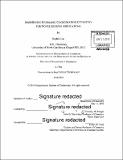Harnessing inorganic coordination chemistry for novel sensing applications
Author(s)
Liu, Sophie, Ph. D. Massachusetts Institute of Technology
DownloadFull printable version (24.46Mb)
Other Contributors
Massachusetts Institute of Technology. Department of Chemistry.
Advisor
Timothy M. Swager.
Terms of use
Metadata
Show full item recordAbstract
We explore strategies to exploit the rich chemical reactivity available to inorganic coordination complexes in order to realize chemiresistive detectors, electronic device elements that undergo a change in resistance in the presence of analyte, through either incorporation of a conductive material (i.e., carbon nanotubes) or reliance on intrinsic conductivity. We seek to elucidate fundamental principles that govern these chemical detectors and use these insights to aid our design of effective chemical detection systems. In Chapter 1, we give an overview of chemiresistors in chemical detection with an emphasis on those based on carbon nanotubes. In Chapter 2, we employ metalloporphyrin complexes bearing late first-row transition metal centers in composites with single-walled carbon nanotubes (SWCNTs) in a chemiresistive sensor array capable of classifying various volatile organic compounds (VOCs) through the use of statistical analyses. In this study, we hypothesize that a swelling-based transduction mechanism is a significant contributor to the observed response. In Chapter 3, we demonstrate that the metalloporphyrin-SWCNT chemiresistor can be optimized through rational design for the detection of amines relevant to meat spoilage. Within the meso-tetraarylporphinatocobalt manifold, increasing the electron deficiency of the metal center through synthetic tuning can increase the device's sensitivity to amines, allowing for a detector to monitor the decomposition of meat. In Chapter 4, we describe the design of a sensor for carbon monoxide, fabricated from carbon nanotubes and an organocobalt(III) complex. This work represents the first example of a carbon monoxide detector based on carbon nanotubes functionalized with a molecular species. In Chapter 5, we immobilize a composite of SWCNTs and poly(4-vinylpyridine) onto glass substrates decorated with gold electrodes and then incorporate PdCl₂ into the devices to give chemiresistive detectors for vapors of thioethers. We also show that incorporating permanaganate into the polymer leads to a chemiresistive detector for VOCs susceptible to oxidation. In Chapter 6, we employ 2-D metal-organic frameworks as chemiresistors for the detection of volatile compounds, exploiting their intrinsic conductivity. These materials are the first of their class to be utilized as chemiresistive detectors because of their uniquely high conductivities.
Description
Thesis: Ph. D., Massachusetts Institute of Technology, Department of Chemistry, 2016. Cataloged from PDF version of thesis. Includes bibliographical references.
Date issued
2016Department
Massachusetts Institute of Technology. Department of ChemistryPublisher
Massachusetts Institute of Technology
Keywords
Chemistry.